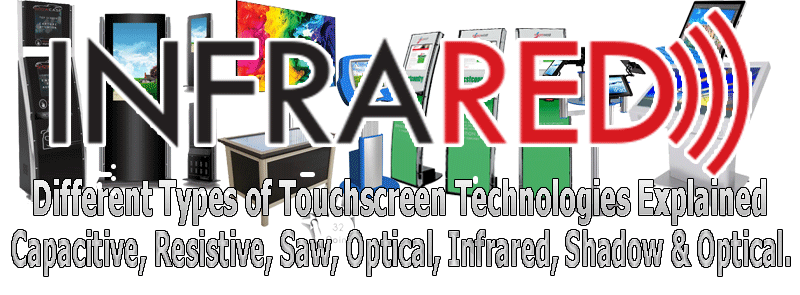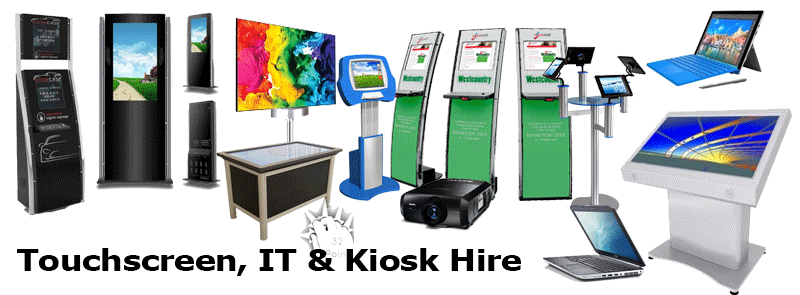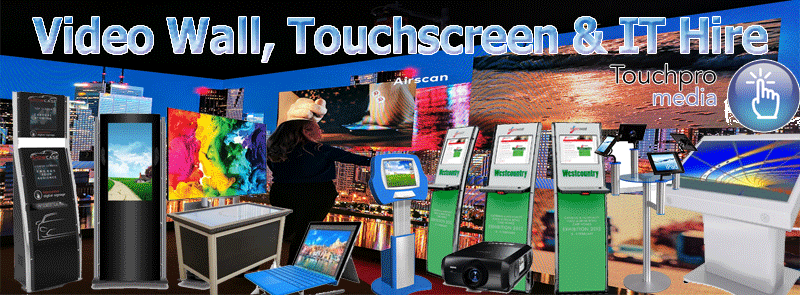
Different Types of Touchscreen Technologies : Infrared Explained
| Call Us | Email Us | Website |
All touchscreens are not the same.
They achieve the same thing; you place your finger or stylus on the screen and your finger or stylus acts like a cursor or mouse pointer, but there are several different types and they achieve this by using different builds and technologies. There are also pros / cons – advantages and disadvantages to each type.
The four most widely used touchscreen technologies are:
- Capacitive Touchscreens
- SAW (surface acoustic wave)
- Resistive
- Infrared
INFRARED touchscreens are most widely used in public and outdoor settings. They can be used with fingers, gloves and any other item including stylus’
Infrared touchscreens use two layers of infrared beams that cover the surface of the top glass layer. One layer runs left to right and the other top to bottom. When any item is placed on the surface of the screen thebeams are broken and a processor converts this into the appropriate co-ordinates.
This is a very simplified explanation of how infrared touchscreens work but hopefully explains the basic principle.
Pros / Advantages of Infrared Touchscreens and why you may choose one
- Image Clarity is Perfect
- They are very sensitive and can be touched lightly
- Long Touch Life. The beams are unaffected by repeated use.
- Can be used with gloves and stylus’
Cons / Disadvantages of Capacitive Touchscreens and why you not may choose one
- Dust and damp can gather in the surrounding bezel of the screen and obscure the infrared beams and give false readings.
- Ambient light may affect the beams
If you wanted to investigate Infrared Touchscreen technology further it will be worth investigating Infrared Grids and Infrared Acrylic Projection, but this may be more than most people need to know. The following exert is copied from Wikipedia
Infrared grid
An infrared touchscreen uses an array of X-Y infrared LED and photodetector pairs around the edges of the screen to detect a disruption in the pattern of LED beams. These LED beams cross each other in vertical and horizontal patterns. This helps the sensors pick up the exact location of the touch. A major benefit of such a system is that it can detect essentially any opaque object including a finger, gloved finger, stylus or pen. It is generally used in outdoor applications and POS systems which cannot rely on a conductor (such as a bare finger) to activate the touchscreen. Unlike capacitive touchscreens, infrared touchscreens do not require any patterning on the glass which increases durability and optical clarity of the overall system. Infrared touchscreens are sensitive to dirt and dust that can interfere with the infrared beams, and suffer from parallax in curved surfaces and accidental press when the user hovers a finger over the screen while searching for the item to be selected.
Infrared acrylic projection
A translucent acrylic sheet is used as a rear-projection screen to display information. The edges of the acrylic sheet are illuminated by infrared LEDs, and infrared cameras are focused on the back of the sheet. Objects placed on the sheet are detectable by the cameras. When the sheet is touched by the user, the deformation results in leakage of infrared light which peaks at the points of maximum pressure, indicating the user’s touch location. Microsoft’s PixelSense tablets use this technology.
There is also Optical Touch Screen technology.This also uses infrared beams but involves the beams being projected from the corners. This is a modern technology and is used for video walls and some tabletop computers.
There is also Shadowsense Touchscreen technology which has been patented by Baanto and works by shadows being detected and compared.
To read more on other types of touchscreens use the links below:
SAW Touchscreens Explained
Capacitive Touchscreens Explained
Infra Red Touchscreens Explained
Resistive Touchscreens Explained

Interested in hiring with us? Contact details below:

